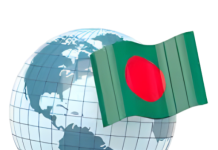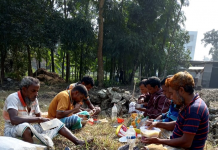Publisher: Routledge,2022
A Book Review by Sadequl Islam
The book depicts the lives of Bangladesh diaspora in the USA, based on the field work of the author in Southern California and New York City. The book is a continuation of the author’s research on Bangladeshi immigrants in other parts of the world, especially, the UK. It covers such topics as oral histories of settlement of early immigrants in the USA from Bangladesh, the American Dream, aspirations and struggles of Bangladeshi diaspora, the social and economic ties they retain with the motherland, and Bangladeshi version of Islam in the USA. The author situates the book in the current field of transnational studies and studies of globalization. As an anthropologist, the author provides an ethnographic account of Bangladeshi diaspora based on sustained observation and interactions with them. He uses the sociologist Bourdieu’s concept of habitus in the transnational context, which refers to socially-determined habits, skills, and shared dispositions of Bangladesh diaspora. The book tries to address a broad question: how to connect Bangladeshi individuals’ motivations, strategies, hopes and dreams, and struggles with the broader historical, political, and economic conditions which shape their lives?
The author notes that the Bangladesh diaspora in the USA, unlike their counterparts in other regions, are diverse and multifaceted. Bangladeshi immigrants to the USA came from different backgrounds and districts. The first wave of Bangladeshi immigrants came from Chittagong to work as slaves in tea plantations in Georgia and Pennsylvania and cotton plantations in the south. Another wave took place in 1780, consisting of workers from Chittagong, Noakhali, and Sylhet who were hired as cheap labourers in ships for loading jute and cotton goods bound for New York and Boston. During the 1880-1950 period, many unskilled Bangladeshi people in the USA were engaged as petty sellers of goods. The book describes the story of a legendary Bangladeshi immigrant mentioned as Chacha who married a black woman and settled in Long Beach and brought 150 relatives from Bangladesh to the USA. Immigration from Bangladesh surged after 1971, induced by the Immigration and Nationality Act of 1965 which allowed family reunifications. Another catalyst was the US DV program. Some Bangladeshi immigrants established grocery shops and others worked in various service enterprises such as gas stations. The author with a Malinowskian approach observed the lives of the Bangladeshi diaspora in Bangladeshi supermarkets, grocery stores, and restaurants. Bangladeshi restaurants with their biriyani, kebab, fish curry, mutton curry, chicken tikka, and buffet lunch were the focal points of social gatherings. The author provides many stories narrated by Bangladeshi immigrants. Ahad, now a Bangladeshi-American, works as a butcher in a poultry shop. He spoke about his golden days as a school teacher in Bangladesh, cursed his identity as a butcher and wanted to go back to Bangladesh ( Ch.2). The book describes the story of a Bangladeshi woman, Dina who was struggling to raise her son in L.A. after her husband died. She never worked in Bangladesh, but now she had to work in America so that her son would get good education. She hates being in America, yet couldn’t think of returning to Bangladesh.
The story of Abdul Alim, in contrast, is quite different. He was grateful to “ Almighty America” which was a dreamland for him. This land provided ample economic and educational opportunities for him and his family members. With his comfortable job at a computer firm, he bought a house in San Diego and an apartment in Bashundhara in Dhaka. He was always ecstatic about visiting the Little Bangladesh around Third Street and Alexandria Avenue in L.A. According to the author, the majority of employed Bangladeshis in southern California were struggling and the majority of women were house wives. The book narrates the story of Ayesha, a Bangladeshi illegal immigrant in L.A. She had a double vision view about America. She thought America was a nice country and a land of opportunities for her two daughters. However, she was living a hellish life because her husband and her in-laws mistreated her regularly; as an illegal immigrant ,she couldn’t visit her mother, brother, and close relatives in Bangladesh. For another Bangladeshi immigrant, Kalim, America was as bitter as hemlock, not as sweet as honey, despite the fact that his parents and close relations lived in the USA.
The book highlights the importance of social and symbolic capital in explaining upward social mobility among immigrants including Bangladeshi immigrants in the USA. Social capital, according to sociologists such as Bourdieu, Coleman, and Putnam, refers to inter-personal and familial relationships and social networks, and shared identity, trust, and values. Symbolic capital refers to capital generated by particular styles of consumption and education of children. Some professional Bangladeshis with their social and symbolic capital managed to bring close relatives from Bangladesh to America and moved up socially and economically. However, for the vast majority, especially DV winners, the socio-economic ladder was often broken in the absence of social and symbolic capital. The book provides the stories of several Bangladeshis who spent thousands of dollars or millions of Takas to come to the USA and were still trapped in 3-D jobs (dirty, dangerous, and demeaning) working daily 12 hours or more and six or seven days a week; yet were struggling to manage their day to day lives, let alone pay off their debts. According to a well-known American economist Raj Chetty, Asian immigrants have much higher level of upward mobility than all other groups in America. One wonders whether Bangladeshi immigrants have higher or lower upward mobility compared to other Asian groups.
Chapter 4 of the book focuses on the Bangladesh diaspora in New York City which hosts the largest concentration of Bangladeshis in America. The Bangladeshi community is one of the fastest growing communities in New York City. The author describes the lives of Bangladeshi people and their social interactions in areas such as Jackson Heights and the Hillside Avenue. Both areas are known for Bangladeshi grocery stores, restaurants, shops, and social gatherings. This year, the intersection of Homelawn Street and Hillside Avenue has been co-named the Little Bangladesh Avenue by the City of New York. The author reports some economic data concerning the Bangladeshi community from the Asian American Foundation: Compared to most of other South Asian communities, Bangladeshis have higher poverty rates, lower levels of education and income, and higher rate of unemployment. This chapter covers such issues as intergenerational cultural differences, parenting philosophies and styles, and involvement in Bangladeshi culture and politics.
The book documents the various forms of connections Bangladeshi immigrants maintain with Bangladesh: visits to Bangladesh to see friends and relatives, investment in real estate in Bangladesh, financial support to close relatives, and donations to charitable purposes including donations to mosques and madrasas. As the author mentions, many first generation Bangladeshi Americans worked and lived in America but were emotionally anchored in Bangladesh. The most dramatic prototype is the story of Chacha, whose real name was Sayedul Haque. As the pioneer of Bangladeshi diaspora in L.A. he helped more than a hundred Bangladeshis to migrate from Bangladesh to America. Furthermore, he used to send money to his relatives and helped build a Madrasa in his home village in Noakhali. His “Sareng Bari in his village eventually became known as ‘ Dollar Bari.” At the end, when he died, he was buried not in L.A. but in his home village in Noakhali reflecting his wish.
In Chapter 6, the author focuses on the lives of Bangladeshis as Muslims in America. He highlights the syncretistic nature of Islam in Bangladesh and states that most Bangladeshi Muslims in America are neither radicals, nor fundamentalists. This chapter also reveals differences in Islamic practices between Bangladeshi Muslims and Muslims from other parts of the world. Many Bangladeshis in America helped relatives in Bangladesh during Eid festivals and gave zakats to eligible people and organizations in Bangladesh. Overall, the book provides a very good account of the aspirations, struggles, and achievements of ordinary members of the Bangladeshi diaspora in the United States. However, the book doesn’t adequately illuminate the various dimensions of lives of the affluent and “successful” segment of the Bangladesh diaspora comprising business persons and professionals such as doctors, dentists, engineers, and computer scientists in major American cities. One reason is that the ethnographic approach is less feasible to peek into the lives of affluent, professionals of the Bangladesh diaspora: they don’t frequent restaurants such as Ghoroa, Sagor on Hillside Avenue, Ittadi in Jackson Heights, Meghna in Little Bangladesh, L.A. The book also doesn’t adequately cover some other dimensions of the Bangladesh diaspora: social issues concerning marriage and divorce, violence and crime in major cities, healthcare, raising kids, financing of higher education of children, culture and recreation, intra- and intergenerational mobility, and involvement in US politics. The book will be of interest to researchers and potential immigrants to America.



